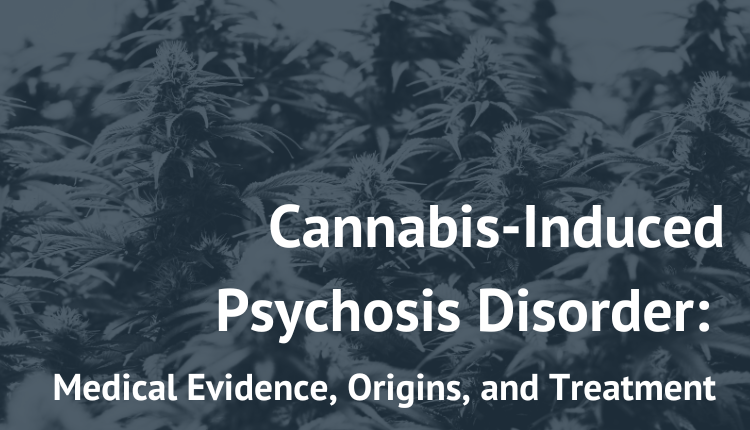Medical Evidence, Origins, and Treatment
New Paradigm Recovery is dedicated to addressing the complexities of substance use and its impact on mental health. Cannabis is often perceived as a safe recreational drug, however, it has been linked to serious mental health issues, including Cannabis-Induced Psychosis Disorder (CIPD). This condition, characterized by symptoms such as hallucinations and delusions, is becoming increasingly prevalent. Despite these dangerous effects of marijuana use becoming more prevalent, this condition is infrequently discussed and often misunderstood. In this article, New Paradigm explores the medical and psychological foundations of CIPD, the reasons behind its rise, and effective treatment strategies. Above all, with the growing use and potency of cannabis, understanding the potential risks is crucial.
Abstract
Cannabis-induced psychosis disorder (CIPD) is an increasingly recognized condition characterized by the onset of psychotic symptoms following cannabis use. This article reviews the medical and psychological evidence concerning the causes and origins of CIPD, explores the reasons behind the recent rise in cases, and discusses the best practices for treating this condition.
Introduction
Cannabis, long considered a relatively safe recreational drug, has recently been associated with an increase in psychotic disorders. Cannabis-induced psychosis disorder is marked by the emergence of psychotic symptoms such as hallucinations and delusions soon after cannabis consumption. This article delves into the medical and psychological underpinnings of CIPD and highlights effective treatment strategies. Additionally, it examines why CIPD cases are more prevalent now than in the past.
Causes of Cannabis-Induced Psychosis Disorder
Pharmacological Basis
The primary psychoactive component of cannabis, Δ9-tetrahydrocannabinol (THC), is known to affect the brain’s endocannabinoid system, which plays a crucial role in modulating neurotransmitter release. THC acts on cannabinoid receptors (CB1 and CB2), particularly influencing the CB1 receptors located in the central nervous system. This interaction can thus disrupt normal neural processes and trigger psychotic symptoms in susceptible individuals.
Genetic and Biological Factors
Research indicates that genetic predisposition plays a significant role in the development of CIPD. Variations in genes related to the dopaminergic system, such as COMT and AKT1, have been linked to an increased risk of psychosis following cannabis use. Additionally, individuals with a family history of schizophrenia or other psychotic disorders are more vulnerable to developing CIPD .
Psychological and Environmental Factors
Psychological stress, trauma, and environmental factors such as peer pressure and socio-economic status also contribute to the risk of CIPD. Adolescents and young adults, whose brains are still developing, are particularly susceptible to the adverse effects of cannabis on mental health.
Medical and Psychological Origins of CIPD
Neurochemical Changes
Cannabis use leads to alterations in brain chemistry, particularly affecting dopamine levels. Moreover, dopamine dysregulation is a well-established factor in the development of psychotic symptoms. THC-induced increases in dopamine release can precipitate psychotic episodes, especially in individuals with an underlying vulnerability.
Structural Brain Changes
Imaging studies have shown that chronic cannabis use can result in structural brain changes, particularly in regions such as the hippocampus and prefrontal cortex, which are involved in memory, cognition, and executive function. These changes may predispose individuals to psychosis by disrupting normal brain function.
Treatment of Cannabis-Induced Psychosis Disorder
Acute Management
Immediate management of CIPD involves ensuring patient safety and providing symptomatic relief. Hospitalization may be necessary for severe cases. The use of antipsychotic medications, such as olanzapine or risperidone, can help control acute psychotic symptoms. Additionally, benzodiazepines may treat related agitation and anxiety.
Long-Term Treatment
Long-term treatment strategies focus on preventing relapse and addressing underlying issues. These may include:
- Antipsychotic Medications: Maintenance therapy with antipsychotics may be necessary for individuals with persistent symptoms or a high risk of relapse.
- Psychotherapy: Cognitive-behavioral therapy (CBT) can help patients develop coping strategies, manage stress, and reduce the risk of future psychotic episodes.
- Substance Use Treatment: Programs designed to address cannabis dependence and promote abstinence are crucial for preventing relapse and improving overall outcomes.
Comprehensive Care
A multidisciplinary approach involving psychiatrists, psychologists, and addiction specialists is essential for effective treatment. Family support and education are also critical components, helping patients adhere to treatment plans and avoid cannabis use.
Rise in CIPD Cases: Analyzing the Trends
Increased Potency of Cannabis
One significant reason for the recent increase in CIPD cases is the rising potency of cannabis products. Modern cannabis strains contain much higher levels of THC than those available in the past. Higher THC concentrations increase the likelihood of adverse psychiatric effects, including psychosis.
Greater Accessibility and Use
The legalization and decriminalization of cannabis in many regions have led to increased accessibility and use, particularly among adolescents and young adults. This demographic shift contributes to the higher incidence of CIPD, because younger individuals are more susceptible to the drug’s psychotic effects.
Improved Awareness and Diagnosis
Enhanced awareness of cannabis-related mental health issues among healthcare professionals has led to better recognition and diagnosis of CIPD. Increased research and clinical attention have also contributed to identifying more cases that might have previously been overlooked or misdiagnosed.
Conclusion
Individuals with a history of substance use disorders may face a greater risk of developing cannabis-induced psychosis, as their brains may be more susceptible to the side effects of THC. This risk is particularly concerning for those already struggling with mental illnesses, as the combination of cannabis use and pre-existing conditions can exacerbate symptoms. Moreover, ongoing substance abuse can significantly impair the effectiveness of treatment for psychosis and other related conditions, creating a challenging cycle that can be difficult to break without professional help.
Cannabis-induced psychosis disorder is a significant mental health concern linked to the increased potency and prevalence of cannabis use. Understanding the genetic, biological, and environmental factors contributing to CIPD is essential for developing effective treatment and prevention strategies. Thus, as cannabis continues to become more widely used and accepted, ongoing research and public health efforts are crucial to mitigate the risks associated with its use.
References
- Howlett, A. C., & Abood, M. E. (2017). CB1 and CB2 receptor pharmacology. Advances in Pharmacology, 80, 169-206. 10.1016/bs.apha.2017.03.007
- Tai, S., & Fantegrossi, W. E. (2014). Synthetic cannabinoids: pharmacology, behavioral effects, and abuse potential. Current Addiction Reports, 1(2), 129-136.
- Di Forti, M., Sallis, H., Allegri, F., Trotta, A., Ferraro, L., Stilo, S. A., … & Murray, R. M. (2014). Daily use, especially of high-potency cannabis, drives the earlier onset of psychosis in cannabis users. Schizophrenia Bulletin, 40(6), 1509-1517.
- Zammit, S., Moore, T. H., Lingford-Hughes, A., Barnes, T. R., Jones, P. B., Burke, M., & Lewis, G. (2008). Effects of cannabis use on outcomes of psychotic disorders: systematic review. The British Journal of Psychiatry, 193(5), 357-363.
- Bossong, M. G., & Niesink, R. J. M. (2010). Adolescent brain maturation, the endogenous cannabinoid system and the neurobiology of cannabis-induced schizophrenia. Progress in Neurobiology, 92(3), 370-385.
- Paparelli, A., Di Forti, M., Morrison, P., & Murray, R. M. (2011). Drug-induced psychosis: how to avoid star gazing in schizophrenia research by looking at more obvious sources of light. Frontiers in Behavioral Neuroscience, 5, 1.
- Winstock, A. R., & Barratt, M. J. (2013). Synthetic cannabis: a comparison of patterns of use and effect profile with natural cannabis in a large global sample. Drug and Alcohol Dependence, 131(1-2), 106-111.
- Castellanos, D., & Thornton, G. (2012). Synthetic cannabinoid use: recognition and management. Journal of Psychiatric Practice, 18(2), 86-93.
- Cohen, K., & Weinstein, A. (2018). Synthetic and non-synthetic cannabinoid drugs and their adverse effects—a review from public health prospective. Frontiers in Public Health, 6, 162.
- Vandrey, R., Dunn, K. E., Fry, J. A., & Girling, E. R. (2012). A survey study to characterize use of Spice products (synthetic cannabinoids). Drug and Alcohol Dependence, 120(1-3), 238-241.
- Abdulrahim, D., & Bowden-Jones, O. (2015). Guidance on the clinical management of acute and chronic harms of club drugs and novel psychoactive substances. Novel Psychoactive Treatment UK Network (NEPTUNE).
- Tait, R. J., Caldicott, D., Mountain, D., Hill, S. L., & Lenton, S. (2016). A systematic review of adverse events arising from the use of synthetic cannabinoids and their associated treatment. Clinical Toxicology, 54(1), 1-13.
- Gage, S. H., Hickman, M., & Zammit, S. (2016). Association between cannabis and psychosis: epidemiologic evidence. Biological Psychiatry, 79(7), 549-556.
- Leweke, F. M., & Koethe, D. (2008). Cannabis and psychiatric disorders: it is not only addiction. Addictive Biology, 13(2), 264-275.

